It’s very likely that the first time you experienced essential oils was through inhalation. Our noses are the perfect gateway for the volatile compounds in essential oils, in fact they are designed precisely to engage with the smells of our world. Perhaps this is why inhaling essential oils is the most popular way to experience aromatherapy. This article will walk you through the reasons for using inhalation, its pros and cons, and the many modes and devices that are available to us.
I will be using the term “inhalation” to mean the act of inhaling essential oils, or the passing of their compounds into our body via the airways. Inhalation can be either active or passive, and the choice of the tools we use to facilitate it will depend mostly on many different factors which will be described below.
When the airway is the best way!
One of our students asked recently if there is a “best” way to use essential oils. The honest answer is that it depends on what you’re trying to achieve. Once you know this, you choose the mode of application that will get the effect you want in the most efficient and safest way possible. For example, if you want to address a skin condition, applying essential oils to the skin – suitably diluted – should be the obvious choice. So when does inhalation come into play? Let’s dive in!
1. Psychological support
Any time we want to work with a person’s state of mind, whether it’s calming anxiety or increasing focus, inhalation is the quickest and most effective way to do so. This is because of how our olfactory system is wired, with the olfactory bulb being connected directly to the “primary olfactory cortex”, a collection of regions of our brain which then leads directly into structures that also function in memory and emotion. These include the pyriform cortex, the amygdala and the hippocampus.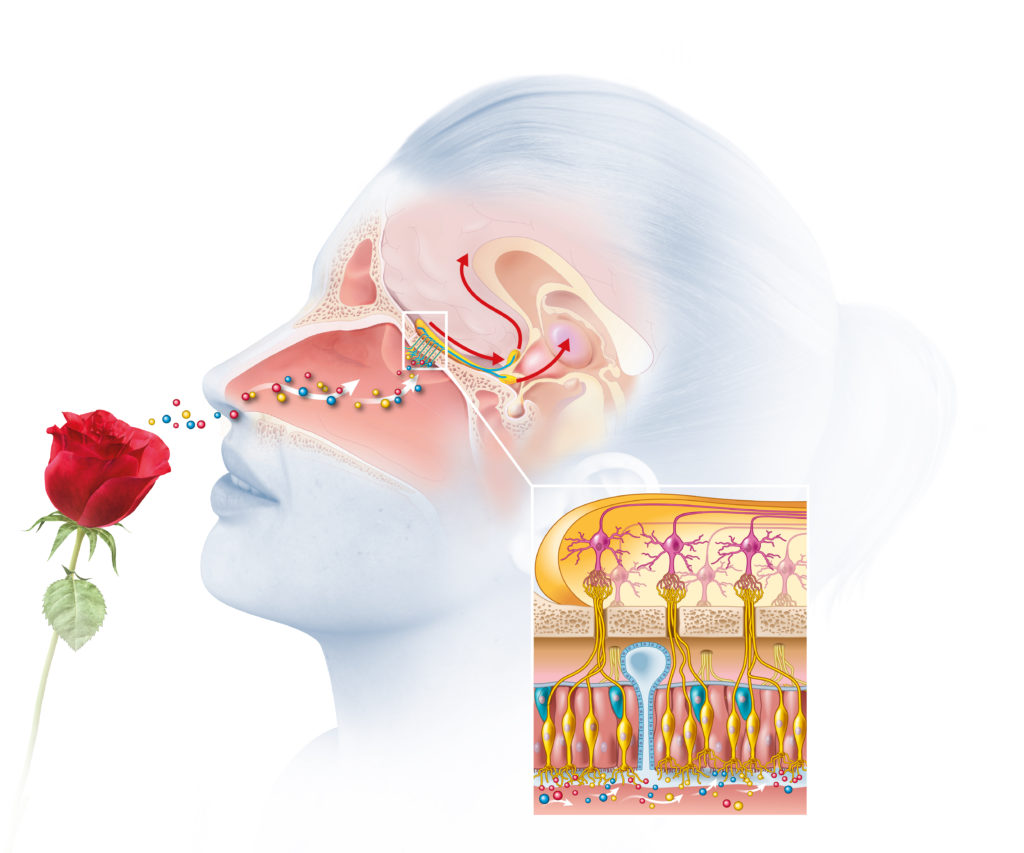
The only thing between your nose and your brain is the olfactory nerves. There is no “end organ” – no equivalent to the tongue, the inner ear or the eyes – no relays, no delays. In fact, research tells us that we react to a scent milliseconds before we consciously register it. So if your aim is a quick refocus of the mind, inhalation is your friend.
2. Respiratory health
If you’re wanting to tackle a respiratory issue, such as congested nasal passages, a cough or a cold, inhaling essential oils will get them directly where they are needed – your airways and lungs – again with no delay. Personal inhalers (nasal inhaler tubes) or steam inhalation are especially useful for this. And chest rubs, while applied to the skin, are basically a way to ensure long-term sustained inhalation. In this case your skin is the diffuser, and we’ll look at that a little bit later.
3. Personal or environmental fragrance
The fact that inhalation is how we consume fragrance may be glaringly obvious but I think it still deserves to be mentioned here as a reminder that even if the original intention is “just” to fragrance either yourself or the space you’re in, the same considerations regarding safety and efficiency apply as if we were using essential oils with a therapeutic effect in mind.
What do you want to do?
Before you decide on which device to use for inhalation, a good starting point is to determine what your goals are, and who is going to be benefiting from the application. Then, based on these goals, you can choose the mode of application that is best suited for your particular situation.
This article isn’t going to address the choice of essential oils to use, just the way to use them, which is an important part of the decision making process. You may have identified the most potent essential oil for a purpose, but if the way you apply it is not ideal, you’re limiting the potential benefit. As we explain in our Kinetics Masterclass, therapeutic effect is about having the right substance in the right place at the right dose and with the right frequency.
So hopefully, answering the following questions will help you determine which tool is best for your particular case scenario.
-
Is this a personal issue or an environment issue?
-
Is this an acute issue that needs an immediate fix or does the effect need to be longer-lasting?
-
Can the recipient actively participate or does this need to be a passive experience?
For example, someone is having an anxiety attack and we want them to inhale a calming scent to help reduce their anxiety. This is an acute issue and we can reasonably expect the person to be able to actively smell say an inhaler stick. On the other hand, if we want to induce a calming atmosphere before a meditation session in a studio, we will want a longer-lasting effect that doesn’t require each participant to come and smell the oils.
Of course, there are myriad other scenarios and factors that will help you determine the best way forward in your particular case, and hopefully the rundown of the tools used will help you as well.
What to be aware of
One of the most common mistakes with inhalation/diffusion is over-dosing. If you are looking for a psychological benefit, you do not want anything very intense. Less really is more, as too much scent can overwhelm the system and cause stress when we want to induce relaxation, for example.
I should also mention habituation. Whenever we keep smelling the same thing, our nose (actually our brain) quite quickly habituates to what we are smelling, so it smells less intense or even becomes imperceptible unless we leave the space and come back. This does not alter the effects of the essential oils on a physiological level. But it often seems like it – if you can barely smell the essential oil, how can it be working? Well, research has shown that essential oils can influence us when we are asleep, and we are not conscious of smelling anything at all! But perhaps more importantly, we do know from research that low-level fragrancing is perceived by the brain, even when we are not consciously aware that we are smelling something. In cases when a clear perception of the smell is important you can either opt for intermittent diffusion, or use a personal inhaler. See below.
Constant vs intermittent
As previously mentioned, low-level diffusion is fine to do for several hours, and low-level means barely perceptible. More intense diffusion, whether for psychological or respiratory benefit, is most effective when intermittent. This is partly to do with habituation, not habituation to the odor, but to the effect. After 30-60 minutes, the benefits of inhalation tail off, and the best way to restore them is by inhaling only plain air for a while before another inhalation period. Some diffusers come with timers that can be pre-set, and so these are ideal for intermittent diffusion.
The tools
Now that we’ve explored the different general parameters of inhalation, let’s look at the tools available to us. I will categorize them based on whether they are intended for personal or environmental use, and then work through each category according to the intensity of inhalation – from the least intense to the most intense.
Personal use
This means that the aromatherapy is intended for one person only. As well as targeting just one person, this is very useful in scenarios where we need to be mindful of other people (or pets) in the same space and their potential sensitivities. In most personal use scenarios it’s easy to control the intensity of inhalation, and should an adverse reaction occur we can very simply remove the source of scent.
1. Aroma jewelry
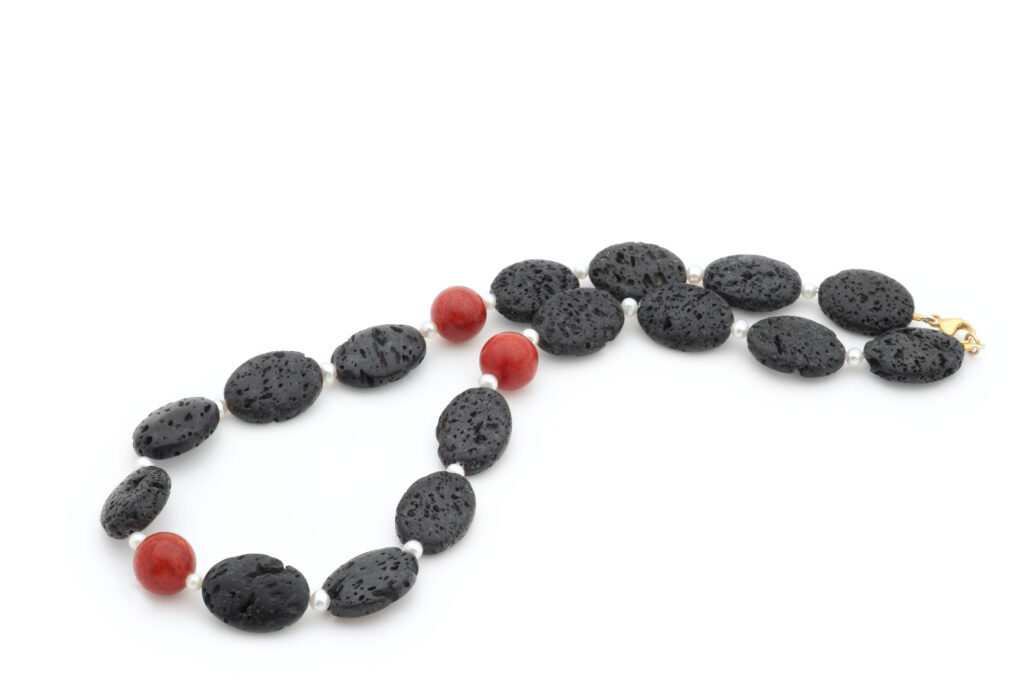 A bracelet or pendant is a very safe, passive personal inhalation device. Usually it comes in the form of a metallic enclosure (with a finely engraved cover) that is fitted with a felt pad to drop essential oils onto. Sometimes it is made of porous stone (lava stones, some forms of coral), unglazed clay, or wood which is then infused with the fragrance. The pendants in particular are a nice nod to the historical use of pomanders. These were balls, often metal, that contained various fragrant materials with the intent to keep the wearer in good health or just smelling good. They were either carried or worn.
A bracelet or pendant is a very safe, passive personal inhalation device. Usually it comes in the form of a metallic enclosure (with a finely engraved cover) that is fitted with a felt pad to drop essential oils onto. Sometimes it is made of porous stone (lava stones, some forms of coral), unglazed clay, or wood which is then infused with the fragrance. The pendants in particular are a nice nod to the historical use of pomanders. These were balls, often metal, that contained various fragrant materials with the intent to keep the wearer in good health or just smelling good. They were either carried or worn.
Pros: Discreet, low level, easy to use and fashionable.
Cons: Not easy to change fragrance, especially with stone and wood jewelry. Essential oils may come in contact with skin.
Suitable for: A fashionable everyday use of aromatics for a quick mental pick-me-up or your favorite fragrance.
2. Perfume oils and chest rubs
Sometimes our skin becomes the medium for essential oil inhalation. This applies to essential oils and blends worn as perfumes (classically on pulse points – your inner wrists and behind the ears), and to chest rubs. In the first case, we’re using our skin rather like the above mentioned aromatic jewelry, just to keep a favored fragrance close to us during the day. In the case of chest rubs, the skin a little below the neck is used with essential oils to ease respiratory issues, typically in a balm or oil base.
Both are good ways to use essential oils, providing safe dilution is used in relation to the person who is going to be wearing the product, and to the oils used.
Pros: No extra device needed, your skin is always available. Chest rubs ideal for night use.
Cons: Risk of skin irritation, and not easy to remove scent if overwhelm happens (washing off/rubbing is required).
Suitable for: Personal fragrance; respiratory issues.
3. Aromatic patches and other devices pinned to clothes
You can purchase specialized patches with essential oils that can be attached to clothes. These have an adhesive side that sticks to the fabric, and then an aromatic side with a cover that can be peeled off as needed to adjust intensity. They are designed to be used in a medical setting for people who are either undergoing a procedure or recovering from one. This usually means their active participation is limited as they may or may not be fully conscious or have restricted mobility. You can mimic a patch by using a safety or clothes pin to attach a piece of gauze or a cotton ball, suitably aromatized, to your clothing.
The placement is usually on or around the clavicle (lapel of a shirt), and you should not need more than 2-3 drops of essential oil.
Pros: Usable without active participation of the person, discreet, easy to switch if needed.
Cons: Can be costly if using pre-made patches. Lasts a shorter time if exposed to air.
Suitable for: Clinical uses, in-patient interventions, dental offices and other situations where the person cannot actively inhale essential oils.
4. Personal inhalers – inhaler sticks
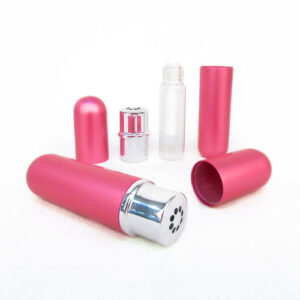 This is one of the most popular ways to inhale essential oils, and a wide variety of pre-made inhaler sticks is available. There are those already containing essential oils, either from big brands, like Vicks, or from small aromatherapy businesses. There are also blank ones where you add your own essential oils. Mostly made of plastic, you have a tube with an opening at the top and smaller openings at the bottom (to let air in), and a cotton wick dipped in essential oils. The tube is protected by a cap that needs to be taken off for use. Aside from plastic, glass and aluminum devices are available, and I’ve recently seen both wooden and stainless steel options.
This is one of the most popular ways to inhale essential oils, and a wide variety of pre-made inhaler sticks is available. There are those already containing essential oils, either from big brands, like Vicks, or from small aromatherapy businesses. There are also blank ones where you add your own essential oils. Mostly made of plastic, you have a tube with an opening at the top and smaller openings at the bottom (to let air in), and a cotton wick dipped in essential oils. The tube is protected by a cap that needs to be taken off for use. Aside from plastic, glass and aluminum devices are available, and I’ve recently seen both wooden and stainless steel options.
Makeshift personal inhalers can include: small glass or tin jars with cotton balls, paper towel or salt crystals to hold essential oils, repurposed essential oil bottles.
You need to actively inhale from the stick and unless you’re holding it in front of somebody’s nose, the person also needs to have a free hand (or two) to use. At the same time you can easily control the depth of breath and increase the inhaled amount of essential oils. Inhaler sticks are very convenient for travel, and generally for use away from the home.
Pros: Very portable, versatile, can have more than one inhaler stick with you. Control of intensity. Very discreet.
Cons: You need a free hand to open and use. Can be tricky to replace the cotton wick. Plastic inhalers can degrade in contact with essential oils and may not be recyclable if contaminated.
Suitable for: Upper respiratory issues, such as congested nasal passages; mental support during the day.
Note on plastic: As much as they are ubiquitous, plastic inhaler sticks may present an unexplored risk as there is some evidence that undiluted essential oils can degrade the plastic and leach plasticizers which may then be inhaled. We recommend discarding plastic inhalers after 2-3 weeks of use. Use glass/aluminum alternatives where possible as it’s generally a good idea to limit our use of plastic materials.
5. Steam inhalation and facial steamers
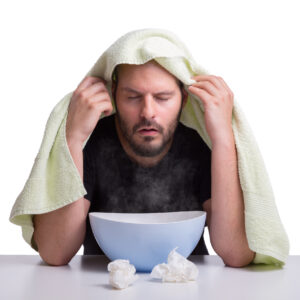 I’m putting these two modalities together as they are used for a very specific purpose, require full participation of the person involved, and they are the most intensive types of personal inhalation. For steam inhalation, you put 2-5 drops of an essential oil into a bowl of hot water (not boiling, about 45°C, 113°F), lean over the bowl and inhale for about 10 minutes. There are various factors that you can vary to find the right degree of intensity: the amount of essential oil, the temperature of the water, the distance between the water and your nose, and whether or not you cover your head with a towel. If it’s too intense you will know!
I’m putting these two modalities together as they are used for a very specific purpose, require full participation of the person involved, and they are the most intensive types of personal inhalation. For steam inhalation, you put 2-5 drops of an essential oil into a bowl of hot water (not boiling, about 45°C, 113°F), lean over the bowl and inhale for about 10 minutes. There are various factors that you can vary to find the right degree of intensity: the amount of essential oil, the temperature of the water, the distance between the water and your nose, and whether or not you cover your head with a towel. If it’s too intense you will know!
Facial steamers work similarly, except you do not need to be concerned with temperature – you just place your face into the top of the device, and breathe. These products were originally made as home facial steamers, but can also be used for inhalation.
Both of these are very intense and need to be used with caution, as there are risks, not only from too much intensity causing eye and airway irritation, but also skin irritation, though this is not common. Steam inhalation is an extremely efficient way to address upper respiratory issues.
Pros: Very efficient for the intended purpose.
Cons: Intense, can get overwhelming easily, increased risk of skin and airway irritation, bowls of hot water cool down quite quickly.
Suitable for: Sinusitis, respiratory infection relief.
Environmental use
The following is a list of various devices that are used to diffuse essential oils in a wider space, with the goal of them being smelled by a number of people at the same time. Which one of the diffusers you’re going to use will largely depend on the size of the space and desired intensity of scent. Generally speaking the intensity will always be lower than when using a personal inhalation tool, and so the therapeutic benefits in relation to how much essential oil is actually used may be diminished somewhat – you’ll get less for your drop, so to speak. Low intensity inhalation is perfectly fine if we’re looking for psychological effects. However, for more physiological interventions, such as dealing with congested airways, the personal approach will often be more beneficial.
When diffusing essential oils in a shared space we also have to take into account the safety of any other people or pets that may need to use the area. This is especially true for schools, kindergartens, and spas where people spend long periods of time. Generally speaking the more intense the diffusion the shorter time it should be happening for. Low-level diffusion, when the scent is barely noticeable, poses little to no risk even if done over several hours, and may even be beneficial. Intense diffusion should be happening intermittently. Always make sure you can air the room quickly and efficiently if needed.
As with personal inhalation, the following list is arranged in terms of intensity, from the least intense to the most intense modality.
1. Passive/evaporative diffusion (clay stones, potpourri, reed diffusers)
This is the simplest way to get volatile molecules into the space around you. Essential oils will evaporate on their own if left in the open (this is why we can smell them), and all you need is something you can easily put them onto and allow them to slowly evaporate. There are many ways you can accomplish this, from a simple cotton ball placed near you, through unglazed clay and porous stones, all the way to reed diffusers. You can even use a cleaned up pine cone, or any dried plant material to create a bespoke potpourri (from French, meaning “smelly bowl”). Whichever tool you choose, passive diffusion will help create a constant, low-level, scented environment.
Pros: Cheap, accessible, low-level and low risk.
Cons: Once an essential oil is put on a diffuser like that it’s not easy to change the scent or clean it, difficult to increase intensity above a certain level.
Suitable for: Low-level environmental fragrancing, psychological support.
2. Heat-based diffusers
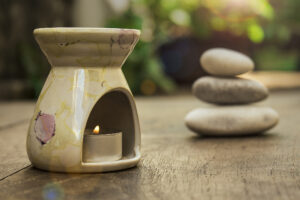 These also take advantage of the volatile nature of essential oils and just add heat to help the molecules disperse into the air, which makes for a more intense diffusion compared to passive diffusers. A common example is a candle burner (aroma lamp), which comprises an upper chamber/bowl for water, with a tea light candle below. A few drops of essential oil are added to the water, floating on top and evaporating as the water gets warmed up by the candle.
These also take advantage of the volatile nature of essential oils and just add heat to help the molecules disperse into the air, which makes for a more intense diffusion compared to passive diffusers. A common example is a candle burner (aroma lamp), which comprises an upper chamber/bowl for water, with a tea light candle below. A few drops of essential oil are added to the water, floating on top and evaporating as the water gets warmed up by the candle.
There are two main safety risks with this type of diffuser: firstly, the open flame, especially in combination with highly flammable substances such as essential oils; and secondly, if the water is allowed to evaporate, the remaining essential oils are oxidized so quickly they form a resin at the bottom of the bowl and their constituents degrade. Some heat-based diffusers use wax melts instead of water.
Other forms of heat-based diffusers are those that you plug either into the cigarette lighter socket in your car or a USB port of your computer (or your car). They have a metal sheet inside that gets heated up, and a felt pad with essential oils is placed on top of it. This is safer than candle diffusers as no direct flames are involved. These look more or less like regular USB sticks, but you can add essential oil, and when plugged in they do a very nice job of diffusion!
One of the oldest types of device is a light bulb ring, or “lantern diffuser”. This is a ceramic ring that is concave so it can hold liquid. It is place directly onto a light bulb, which provides a source of heat. These are not the most efficient devices, but they do the job. If you use them with an LED light bulb the heat factor doesn’t apply and they act as a passive diffuser.
Contrary to popular belief heating essential oils for a short time, in this case until they evaporate, does not degrade their therapeutic properties. That is unless they are being actively burned.
Scented candles technically fall under this category as well, although not many contain just essential oils as it is challenging to formulate a strong, long-lasting fragrance with them.
Pros: Relatively quick diffusion, make for a nice ambiance.
Cons: Fire hazard for candle diffusers. Not easy to clean and need to be supervised.
Suitable for: Medium intensity environmental fragrancing.
3. Fan-based diffusers
Another way to encourage essential oil molecules to disperse is through the use of a fan. These diffusers usually have either a felt pad or filter paper pad that is placed close to a fan, which then blows through the pad and diffuses the essential oils. Fan-based diffusers come in many sizes, from car plug-in ones to larger models. You can also turn any standing fan into a diffuser simply by pinning a tissue or paper towel with essential oils to the protective cage. This type of diffusion is simple and elegant.
Pros: Easy to clean (change filter pads) and change scents. No heat or water involved. Uses little essential oil.
Cons: Can be noisy.
Suitable for: Shorter-term, more intense environmental diffusion.
4. Water-based/ultrasonic diffusers
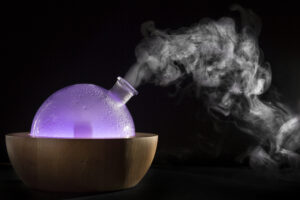 The underlying principle of water-based ultrasonic diffusers is that you pour water into the tank of the diffuser, add essential oils, and the device uses ultrasound vibrations to get the volatile molecules into the air. These come in many shapes and sizes, and they can bring both sound and light effects to the table, as well as various “mist” options. They are often used in spas and meditation or yoga studios where they add to the atmosphere. The decorative aspect is possibly their biggest advantage over other forms of diffusion, that and the fact that they act as a humidifier as well.
The underlying principle of water-based ultrasonic diffusers is that you pour water into the tank of the diffuser, add essential oils, and the device uses ultrasound vibrations to get the volatile molecules into the air. These come in many shapes and sizes, and they can bring both sound and light effects to the table, as well as various “mist” options. They are often used in spas and meditation or yoga studios where they add to the atmosphere. The decorative aspect is possibly their biggest advantage over other forms of diffusion, that and the fact that they act as a humidifier as well.
If this is your preferred choice of a diffuser, try to find one that has a timer that switches it off after a certain period of time and make sure to clean the tank and change the water regularly to prevent mold and bacterial growth.
Pros: Many design options, color and sound effects. Combination of humidifier and essential oil diffusion can be beneficial.
Cons: Water means possible microbial contamination. Usually not very easy to clean or change scent. Water mist can damage furniture and add unwanted humidity to the room. Often made of plastic parts.
Suitable for: Adding ambiance, possibly soothing dry cough if combined with humidifier.
5. Atomizers/nebulizers
These work with pure essential oils which are nebulized (transformed into a very fine spray) by a steady, strong stream of air. They often have a very interesting look, reminiscent of an alchemist’s lab. The absence of heat and water makes their use a little more straightforward, however cleaning a nebulizer, if you want to change the essential oil, can be complicated and requires isopropyl alcohol or similar diluent. Nebulizers provide an intense experience and use up a fair amount of essential oil. There is a USB atomizer available as well, pluggable into your computer. This one sends a whiff of pure essential oil into the air in regular intervals based on the settings. It’s fairly intense and I found it impractical as it tends to leave a layer of essential oil on the surface surrounding it.
(There is a also a medical kind of nebulizer, and this one comes with a mask. It is used, mostly in hospitals and clinics, for dosed personal inhalation.)
Pros: More intense environmental diffusion. Interesting look. No water or heat. No plastic.
Cons: Can be a challenge to clean. Use a lot of oil. Can damage polish on furniture where essential oil mist lands.
Suitable for: Short-term, intensive diffusion in a space.
6. Commercial-grade space diffusers
The most intense spacial diffusion comes from commercial grade diffusers and professional installations that are used to scent spaces such as hotel lobbies or shopping areas. They are not really available to the home user, and I wonder if they do have a place in aromatherapy in general, as the safety issues of saturating a space with volatile compounds could outweigh any possible collective benefit. I just wanted to mention them as an option if you wish to diffuse essential oils into a large space and make sure the scent will be perceptible to most people.
Pros: Saturation of a large space.
Cons: Uses lots of oils. High cost.
Suitable for: Large spaces that need to be evenly scented.
To sum up
Looking at the overview of various diffusion tools, you should have a good idea of what the best one is for your intended purpose. There are indeed many variables, which in turn gives you a great deal of freedom to choose what works best for your situation.
In terms of safety and efficacy, less can be more with inhalation; and personal devices may give you a greater impact compared to environmental diffusion.
I hope you found this overview useful and if there is a type of inhalation device we missed in the overview, please let us know so we can add to the lineup.


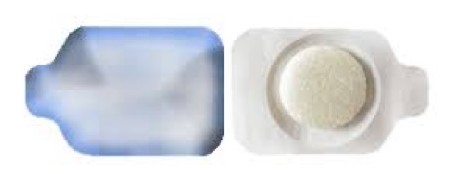


0 Comments